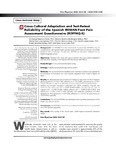Mostrar o rexistro simple do ítem
Cross-Cultural Adaptation and Test-Retest Reliability of the Spanish ROWAN Foot Pain Assessment Questionnaire (ROFPAQ-S)
| dc.contributor.author | López-López, Daniel | |
| dc.contributor.author | Navarro Flores, Emmanuel | |
| dc.contributor.author | Becerro-de-Bengoa-Vallejo, Ricardo | |
| dc.contributor.author | Losa Iglesias, Marta Elena | |
| dc.contributor.author | Palomo-López, Patricia | |
| dc.contributor.author | Sánchez Gómez, Rubén | |
| dc.contributor.author | Calvo-Lobo, César | |
| dc.date.accessioned | 2022-03-08T11:47:38Z | |
| dc.date.available | 2022-03-08T11:47:38Z | |
| dc.date.issued | 2020 | |
| dc.identifier.citation | Navarro-Flores, E., Becerro-De-bengoa-vallejo, R., Losa-Iglesias, M.E., Palomo-López, P., López-López, D., Sánchez-Gómez, R., Calvo-Lobo, C. Cross-cultural adaptation and test-retest reliability of the spanish ROWAN foot pain assessment questionnaire (ROFPAQ-S) (2020) Pain Physician, 23 (1), pp. E1-E6. | es_ES |
| dc.identifier.issn | 1533-3159 | |
| dc.identifier.uri | http://hdl.handle.net/2183/29898 | |
| dc.description.abstract | [Abstract] Background: The ROWAN Foot Pain Assessment Questionnaire (ROFPAQ) may be considered as a self-reported health questionnaire with 45 items to measure foot health problems such as foot pain. To date, the ROFPAQ has only been validated into an English-language version. Objectives: Therefore this study aim was to perform the cross-cultural adaptation and test-retest reliability of the Spanish ROFPAQ version (ROFPAQ-S). Study Design: A cross-sectional descriptive study. Settings: Podiatry and physiotherapy clinical centers. Methods: The recommended forward/backward translation protocol was applied for the procedure of translation and cross-cultural adaptation from United Kingdom to Spain. Results: An adequate internal consistency (Cronbach α) was shown for the 3 domains about cognitive (α = 0.763-0.792), affective (α = 0.751-0.801), and sensory (α = 0.741-0.733) subscales, as well as for the total score (α = 0.822-0.813). Good test-retest reliability by intraclass correlation coefficients (ICC [95% confidence interval]) was shown for the total score (ICC = 0.909 [0.850-0.944]), and each domain such as cognitive (ICC = 0.785 [0.648-0.869]), affective (ICC = 0.995 [0.991-0.997]), and sensory (ICC = 0.662 [0.447-0.794]) subscales. The Spearman correlations (rs) were adequate for the cognitive (rs = 0.81-0.83), affective (rs = 0.73-0.72), and sensory (rs = 0.67-0.63) subscales. Limitations: The original ROFPAQ was developed from a podiatry department of the health care national service. Conclusions: The ROFPAQ-S was shown as a valid and reliable tool with an acceptable use in the Spanish population. | es_ES |
| dc.language.iso | eng | es_ES |
| dc.publisher | American Society of Interventional Pain Physicians | es_ES |
| dc.relation.uri | https://www.painphysicianjournal.com/current/pdf?article=NzAxMA%3D%3D&journal=124 | es_ES |
| dc.rights | Acceso aberto | es_ES |
| dc.subject | Foot | es_ES |
| dc.subject | Pie | es_ES |
| dc.subject | Quality of life | es_ES |
| dc.subject | Calidad de vida | es_ES |
| dc.subject | Chronic pain | es_ES |
| dc.subject | Dolor crónico | es_ES |
| dc.subject | Validation studies | es_ES |
| dc.subject | Estudios de validación | es_ES |
| dc.subject | Health impact assessment | es_ES |
| dc.title | Cross-Cultural Adaptation and Test-Retest Reliability of the Spanish ROWAN Foot Pain Assessment Questionnaire (ROFPAQ-S) | es_ES |
| dc.type | info:eu-repo/semantics/article | es_ES |
| dc.rights.access | info:eu-repo/semantics/openAccess | es_ES |
| UDC.journalTitle | Pain Physician | es_ES |
| UDC.volume | 23 | es_ES |
| UDC.issue | 1 | es_ES |
Ficheiros no ítem
Este ítem aparece na(s) seguinte(s) colección(s)
-
GI-UDISAP - Artigos [196]






